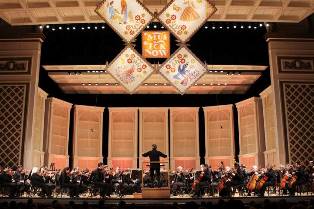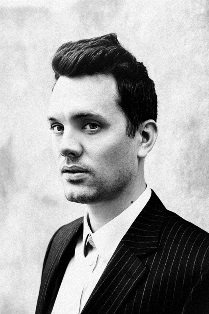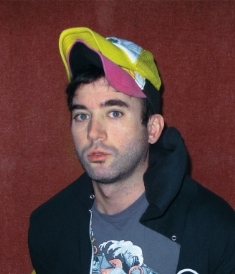
MusicNOW, Cincinnati Symphony Orchestra Score Again
The second concert of the Cincinnati Symphony Orchestra's 2015 collaboration with the MusicNOW Festival March 14 at Music Hall was a special day.

For one thing, it was National Pi Day.
That’s as in the area of a circle equals π r² (pi, or 3.14 to innumerable digits, times the radius of a circle squared).
The U.S. House of Representations actually passed a non-binding resolution on March 12, 2009 recognizing March 14 as National Pi Day, which can be celebrated by eating pies, throwing pies, contemplating pi, etc.
No pies were thrown at the concert, but a lot of good music was heard, expertly performed by music director Louis Langrée and the CSO, with guest artists Bryce Dessner, Sufjan Stevens, Nico Muhly and the ensemble So Percussion.
Again, there was a world premiere, Icelandic composer Daníel Bjarnason’s “Collider.” There were also two CSO premieres: the Suite from “Planetarium” (2012) by Dessner, Stevens and Muhly, arranged for full orchestra by Muhly and David Lang’s “man made” (2013) for percussion quartet and orchestra. The concert ended with Edgar Varèse’s “Amériques” (1973 version).
And again, the hall was packed, with many new faces in the crowd.
The four percussionists of So Percussion – Eric Cha-Beach, Josh Quillen, Adam Sliwinski and Jason Treuting – opened with Lang’s “man made.” (The title refers to the use of found objects by the soloists.) The first section was “choreographed,” with the four players seated in identical positions, and then identically reaching for, cracking and dropping twigs to accompanying woodblock, marimba and xylophone. They then rose to address wine bottles with mallets, in unison and very tunefully indeed. Finally, they moved to marimbas, each player playing his own part and also striking an adjacent garbage can. It evolved into quite a spell-binding piece, with CSO brass prominent and a final section featuring Treuting on drums with ostinato marimba by the other three players. Assuming enough wine bottles could be obtained (there appeared to be a least a dozen for this performance), the work sounded like a promising new addition to the repertoire.
In the words of composer Lang: “This process of finding something intricate and unique, decoding it, regularizing it, and mass producing it reminded me of how a lot of ideas in our world get invented, built and overwhelmed, so I decided to call it ‘man made.’”

The world premiere, Bjarnason’s “Collider,” takes its named from the Large Hadron Collider near Geneva, Switzerland (the largest machine in the world) where research into sub-atomic particle physics is conducted. Bjarnason (who was present for the performance) described it as a piece with a “thrust” to it, “a huge organism with single lines running through it.” After a slow, low-voiced beginning in the double basses, cellos and brass, the rest of orchestra entered gradually, with long-held, intersecting lines. It grew more fragmented and created a variety of tone colors (solo violin, harp, bass clarinet) before a lovely clarinet solo by acting principal clarinetist Jonathan Gunn intervened. It had quiet as well as frantic moments, ending on a big major chord and prompting a well-deserved standing ovation for Bjarnason, Langrée and the CSO.

The Suite from “Planetarium” comprised five movements “Neptune,” “Pluto,” “Moon,” “Saturn” and “Mercury.” Stevens provided the vocals (though they were occasionally hard to distinguish and there was some pure vocalizing). “Neptune” opened against a pink-lit background and soared before coming to an abrupt end, as did “Pluto,” a lovely movement with Muhly on celeste. “Moon” was soft, gentle and nostalgic in tone, drenched with the color of celeste. “Saturn” projected excitement, with a descending vocal line. “Mercury” sparkled, had a constant beat and came closest to recalling the famous “Planets” by Gustav Holst, with a melody arising in the bass. Again, there was a standing ovation.
As it turned out, the most challenging work on the program was Varèse’s “Ameriques.” Composed between 1918 and 1921 (his first composition after emigrating to the U.S.), it is not intended to have specific geographic connotations. Instead it stands for newness and the exploration of pure sound. Varèse described it as “the representation of a state of being” and “the impressions of a stranger who thinks about the extraordinary possibilities of our new civilization.” The CSO performed it in the 1973 version prepared by composer Chou Wen-chung. Scored for a huge orchestra -- the original required 140 players -- it brought together 120 for Saturday’s performance, including 13 percussionists arrayed behind the orchestra. The acoustical towers behind the orchestra were red-lit for atmosphere.
The work is conceived as a mosaic, with ideas frequently interrupting each other. There was a recurring figure for flute at the beginning, also sirens, snare drum and an offstage brass choir, sounds that were not always massive, but kaleidoscopic in effect. It recalls Stravinsky’s 1913 “Rite of Spring,” and not unlike that famous work, caused some audience members to walk out Saturday. (Langrée himself described it as “fascinating, amazing and unbearable.”). A tumult of ideas, it built to a huge climax, reaching maximum volume at the end and receiving yet another standing ovation.
MusicNOW, founded by Dessner in Cincinnati and celebrating its 10th anniversary this year, is a major new asset for Cincinnati. There were concerts over a five-day period March 11-15, including the Cloud Nothings with Will Butler, the chamber ensemble concert:nova with cellist Jeffrey Zeigler, the two CSO collaborations and a final concert March 15 by Perfume Genius, The Lone Bellow and vocalist Mina Tindle. Venues included the Woodward Theater, Music Hall and Memorial Hall, all in the newly revitalized Over-the-Rhine neighborhood. The festival’s first collaboration with the CSO was in 2014. One hopes that it will prosper far into the future (and work with the CSO again).